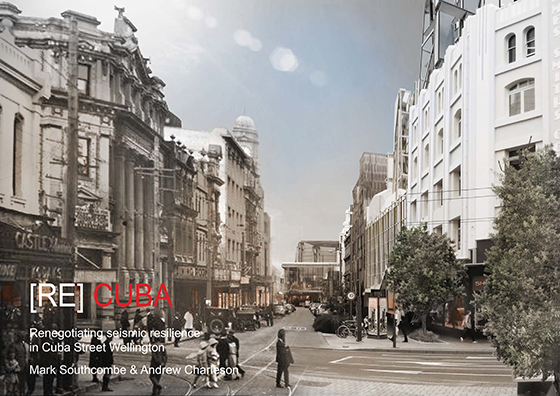Renegotiating seismic resilience in Wellington’s Cuba Street
Two years of project work for fourth-year Architecture students came to fruition on 29 October with the launch of the publication of their work – Re:Cuba Renegotiating the Architecture of Seismic Retrofitting buildings in the Cuba St Heritage Area.

Two years of project work for fourth-year Architecture students came to fruition on 29 October with the launch of the publication of their work – Re:Cuba Renegotiating the Architecture of Seismic Retrofitting buildings in the Cuba St Heritage Area.
Through their design studio projects the students presented a vision to reinvigorate the architecture of Cuba St, while respecting the heritage values of the historic precinct overall. Concurrent with architectural designing, a parallel Technologies course suggested how to increase the seismic resilience of the Cuba St buildings.
This has been a collaborative project between the School of Architecture, Heritage New Zealand and the Wellington City Council.
Speaking at the launch of the publication for Cuba St property owners and wider communities, Bruce Chapman, Heritage New Zealand Chief Executive said that if the heritage buildings that the community values most highly are to survive over the long term we need to get them to a suitable standard of resilience.
“The evidence presented to the Royal Commission on the Christchurch earthquakes by Professor Jason Ingham from the Auckland University Engineering School concluded that to retain sufficient structural integrity to be capable of repair, buildings needed to be strengthened to at least 67% of NBS.”
He acknowledged that the manner in which we endeavour to conserve historic heritage in private ownership is a sensitive issue.
“The distribution of costs and benefits is a matter that needs careful consideration. The approach Heritage New Zealand has been recommending both to central and to local government is to adopt a mixed model of intervention encompassing a combination of regulation and incentives, but more importantly adopting a collaborative approach with a variety of supporting policies that make it easier for owners and councils to work together.
“The Cuba Street precinct was an important choice, a Heritage Area on the council’s District Plan, a listed Historic Area on our Heritage New Zealand list, also with individual heritage building listings, many of which are under seismic scrutiny. This publication resulting from the architectural students’ work will be valuable in informing property owners and the wider world about the options available to strengthen and to sustain our finite heritage building stock.”
Bruce commended the Wellington City Council in leading the way in New Zealand with many fine examples of commercial built heritage conservation, a council that is taking the issue seriously, owners who have demonstrated a willingness to engage and look at alternative solutions, and professional engineers and architects who are willing to think outside the square and come up with creative solutions.
Copies of the publication with full details of the different strategies and benefits offered, and individual and cluster buildings retrofit case studies, are available from the Wellington City Council and from the Victoria University School of Architecture.
The book Re:Cuba is available on the Wellington city council website.
This article originally appeared on Heritage New Zealand website.
